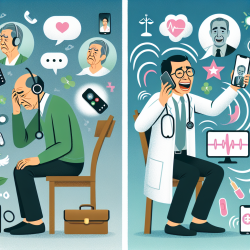In the field of communication disorders, practitioners and researchers constantly seek innovative methods to validate and improve therapeutic interventions. A compelling approach to research in this domain is the application of single-subject randomization designs, as discussed by Susan Rvachew and further elaborated upon in a response by Sheila V. Stager in the Speech and Voice Unit, Intermural Research Program at NIDCD, NIH, Bethesda, MD. This methodology offers a nuanced framework for examining the efficacy of treatments on an individual basis, providing insights that are both statistically and clinically significant.
Single-subject randomization designs pivot on the concept of applying randomization within the treatment sessions of a single subject, which diverges from traditional group-based research methodologies. This approach underscores the potential to discern the direct effects of interventions without the confounding variables often encountered in broader studies. The primary advantage of incorporating randomization into single-subject designs is the ability to make more definitive statements about the treatment's impact, enhancing the internal validity of the study.
For practitioners in the field of communication disorders, understanding and applying the principles of single-subject randomization designs can significantly enhance clinical practice. Here are several ways these designs can be leveraged:
- Improved Treatment Efficacy: By employing randomization, clinicians can more accurately determine whether changes in a patient's condition are attributable to the treatment or to external factors. This precision facilitates the development of interventions that are truly effective, tailored to the individual needs of patients.
- Enhanced Internal Validity: Randomization helps control for internal validity threats, such as maturation, instrumentation changes, and testing effects. This control is crucial for establishing a cause-and-effect relationship between the treatment and the observed outcomes.
- Flexibility in Treatment Application: The use of single-subject randomization designs allows for the examination of treatment effects across different behaviors or conditions within the same individual. This flexibility can lead to a more comprehensive understanding of how various aspects of communication disorders interact and respond to specific interventions.
- Empowering Clinicians with Research Tools: By familiarizing themselves with single-subject randomization designs, clinicians not only enhance their ability to conduct rigorous assessments of treatment outcomes but also contribute to the broader knowledge base in their field. This empowerment through research can lead to more innovative and effective clinical practices.
Despite the advantages, implementing single-subject randomization designs in clinical settings requires careful consideration of ethical and practical aspects. Clinicians must ensure that the randomization process does not interfere with the delivery of necessary treatments or the patients' well-being. Additionally, clear communication with patients and their families about the nature and purpose of the research is essential for maintaining trust and cooperation.
To bridge the gap between research and practice, clinicians are encouraged to engage with the existing literature on single-subject randomization designs and consider how these methodologies can be integrated into their work. Participating in workshops, webinars, and conferences focused on research methodologies in communication disorders can provide valuable insights and skills for applying these designs effectively.
In conclusion, the application of single-subject randomization designs holds significant promise for advancing clinical practice in the field of communication disorders. By rigorously assessing the impact of interventions on an individual level, clinicians can refine their approaches to treatment, ultimately leading to better outcomes for their patients. As the field continues to evolve, embracing and contributing to research methodologies such as these will be key to fostering innovation and excellence in care.
For those interested in exploring this topic further, I highly recommend reading the original research paper on the subject. To read the original research paper, please follow this link: Continuing Peer Commentary Response to "Application of Single Subject Randomization Designs to Communication Disorders Research" by Susan Rvachew.










